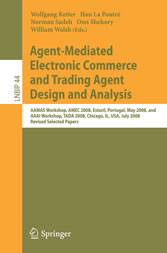Suchen und Finden
Mehr zum Inhalt

Agent-Mediated Electronic Commerce and Trading Agent Design and Analysis - AAMAS Workshop, AMEC 2008, Estoril, Portugal, May 12-16, 2008, and AAAI Workshop, TADA 2008, Chicago, IL, USA, July 14, 208, Revised, Selected Papers
Preface
5
Organization
8
Table of Contents
10
Preventing Under-Reporting in Social Task Allocation
12
Introduction
12
Preliminaries
13
An Exact VCG Mechanism for STAP
16
A Greedy Mechanism for STAP
19
A Greedy Allocation Algorithm
19
A Mechanism That Is Truthful with Respect to Under-Reporting
21
Experiments
22
Discussion and Conclusions
24
References
25
Reasoning and Negotiating with Complex Preferences Using CP-Nets
26
Introduction
26
Representing and Ordering Preferences
27
Ceteris Paribus Nets (CP-Nets)
28
Obtaining Preferences
30
Strategies for Generating Requests
31
Sequential Search Strategy
32
Depth Limited Search Strategy
32
Binary Search Strategy
33
Upper Random Strategy
34
Producer’s Strategy for Counter Offer
35
Experiments
35
Discussion
38
References
39
Using Priced Options to Solve the Exposure Problem in Sequential Auctions
40
Introduction
40
Options: Basic Definition
41
RelatedWork
41
Outline and Contribution of Our Approach
42
Expected Profit for a Sequence of n Auctions and 1 Synergy Bidder
42
Profit with n Unique Goods without Options
42
Profit with n Unique Goods with Options
44
When Options Can Benefit Both Synergy Bidder and Seller
45
The Case When Agents Are Better Off with Options
45
Synergy Bidder’s Profit-Maximizing Bid
49
Simulation of a Market with a Single Synergy Bidder
50
Synergy Bidder’s Strategy
51
Experimental Results: Market Entry Effect for One Synergy Bidder
51
Multiple Synergy Bidders
52
Two Synergy Bidders Interacting Indirectly through the Exercise Price Level
53
Direct Synergy Bidder Competition in the Same Auctions
53
Larger Simulation with Random Synergy Bidders’ Market Entry
54
Discussion and Further Work
55
References
55
Towards a Quality Assessment Method for Learning Preference Profiles in Negotiation
57
Introduction
57
Related Work and Problem Description
58
Quality Assessment Method
60
Quality Measures
60
Negotiation Domains and Profiles
62
Negotiation Strategies of the Opponent
64
Application and Experimental Results
65
Experimental Setup
65
Evaluation
66
Conclusion and Discussion
68
References
69
Using a Memory Test to Limit a User to One Account
71
Introduction
71
TestSpecifics
74
A Small Study with Human Subjects
75
A Game-Theoretic Analysis
77
Conclusions and Future Research
79
References
81
Appendix: Another Test Based on Recognizing Faces
82
Multi-attribute Regret-Based Dynamic Pricing
84
Introduction
84
Dynamic Pricing over Multiple Product Attributes
85
Minimax Regret-Based Algorithms
87
Minimax Regret-Based Attribute Prediction
88
Regret-Based Dynamic Pricing
90
Simulation Results
91
Comparison Strategies
91
Experimental Results
93
Related Work
96
Conclusion
97
References
97
On the Economic Effects of Competition between Double Auction Markets
99
Introduction
99
Background
100
Experimental Setup
101
Software
101
Traders
102
Markets
103
Experiments
103
Measurements
104
Results
105
Discussion
107
Conclusions
111
References
112
A Multiagent Recommender System withTask-Based Agent Specialization
114
Introduction
114
Related Work
116
Recommender Systems
116
Multiagent Recommender Systems
117
MAS Recommendation Model
118
The Agents
118
The Recommendation Algorithm
121
Experimental Results
122
Conclusions
126
References
127
Towards Automated Bargaining in Electronic Markets: A Partially Two-Sided Competition Model
128
Introduction
128
Alternating-Offers Bargaining with Agents’ Deadlines
129
The Proposed Model
133
Equilibrium Strategies
135
Base Case: One Buyer and One Seller
135
One-Sided Competition I: One Buyer and More Sellers
137
One-Sided Competition II: More Buyers and One Seller
138
Two-Sided Competition: More Buyers and More Sellers
138
Conclusions and Future Works
140
References
141
Bidding Heuristics for Simultaneous Auctions:Lessons from TAC Travel
142
Introduction
142
TACTravelGame
143
Bidding Heuristics
143
Marginal-Utility-Based Heuristics
144
Sample Average Approximation
145
Experiments in TAC Travel-Like Auctions
146
Decision-Theoretic Experiments with Perfect Distributional Prediction
147
Setup
148
Results
148
Decision-Theoretic Experiments with Imperfect Distributional Prediction
149
Setup
149
Results
150
Experiments with Competitive Equilibrium Prices
152
Setup
152
Decision-Theoretic Experiments
152
Game-Theoretic Experiments
153
Summary and Discussion of Experimental Results
154
Related Work
154
Conclusion
155
References
156
Applications of Classifying Bidding Strategies for the CAT Tournament
158
Introduction
158
Bidding Strategies
159
Classifying Traders by Bidding Strategies
160
Data Collection
160
Classification Using a Support Vector Machine
161
Classification Using a Hidden Markov Model
162
Alternative Classification Techniques
163
Utilizing Classification to Determine Optimal Action Policies
164
Experimental Results
165
Testing Environment
165
Fee Adjustments
166
Experiments
166
Determining Optimal Actions Using an MDP
169
Conclusion and Future Work
169
References
170
Coordinating Decisions in a Supply-Chain Trading Agent
172
Introduction
172
Overview of the TAC SCMGame
173
Agent Decision Processes
174
Game Balance
175
Agent Design and the Decision Coordination Problem
176
Predicted Sales Volume
177
Future Production Schedule
178
InventoryManagement
179
Central StrategyModule
181
Separate Supply and Demand Models
182
Internal Markets
182
Conclusions and Future Work
183
References
184
The 2007 TAC SCM Prediction Challenge
186
Introduction
186
The Prediction Challenge
186
Prediction Methods
189
Results and Analysis
192
Results
192
Average Daily Errors
192
Differences between Participants across Games
195
Differences between Participants across Days
198
Conclusion
199
References
200
Author Index
201
Alle Preise verstehen sich inklusive der gesetzlichen MwSt.








